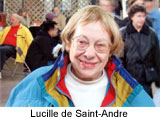
The Story of the Weeping Camel
(Die Geschichte vom Weinenden Kamel)
by Lucille de Saint-Andre
October 9, 2003
 Imagine
the remote, sweeping South Mongolian Gobi Desert, a family of nomadic
shepherds and their herd of camels. The still wide landscape and the close
relationship between the family and their herd are so joyful and liberating
that you just want to jump into the picture. We saw this lovely film after a
string of angst-filled and sexually tedious movies at the recent Toronto
International Festival and we loved it. In fact, at the end we applauded
with gusto.
Imagine
the remote, sweeping South Mongolian Gobi Desert, a family of nomadic
shepherds and their herd of camels. The still wide landscape and the close
relationship between the family and their herd are so joyful and liberating
that you just want to jump into the picture. We saw this lovely film after a
string of angst-filled and sexually tedious movies at the recent Toronto
International Festival and we loved it. In fact, at the end we applauded
with gusto.
The interchange between man and beast, shepherd and camel, reaches its apex during the herd’s spring birth. It also shows the closeness between the individual family members, from grandparents to parents to teenagers to babies in their simple and comfortable tents. The colourful carpets provide a background of the family’s busy chores of taking care of each other and tending their camels.
It is spring in the Gobi Desert and the event of the spring birth has arrived. One young camel suffers through a particularly excruciating birth and family members stand by and help with the delivery. The young camel delivers a rare white calf. She looks at it in total shock then turns in a circle every which way to escape its hungry little mouth. She won’t let it suckle. The family tries to help by holding the mother still, finally milking her but the tiny calf refuses the milk, and rejected, withdraws a little way off, uttering the most heartrending cries. This is particular cruel as we see the other brown calves contentedly suckling and bonding with their mothers.
But wait. There is the ancient ritual of music to soothe the stubborn beast. So the family teenager and his little brother are sent to a distant settlement to summon a musician. We watch the two boys ride their camels through the wide desert. The village opens the eyes of the younger boy to the wonders of unsuspected gadgets and, yes, television. They find the musician who promises to come when he can spare a little time. They return home and he finally roars up on his motorcycle. He plays to the camel mother while the shepherd’s pretty wife strokes her and sings to her. They seem to have hit the right notes because the camel lets herself go, finally feeling loved and understood and weeps big tears. Seeing a close-up of those tears is almost incredible. One loved camel, big tears, and the mother relents and lets her little white calf suckle and all ends well in the Gobi Desert.
This moving tale is made by film students from The Hochschule für Fernsehen und Film München, Germany as their graduation film. Using a fine line between documentary and drama, it offers little dialogue and lets the wonderfully evocative landscape speak for itself. Inspired by Robert Flaherty’s Nannok of the North, it has a keen visual sense of storytelling while capturing the majestic landscape and the simple way of life, which, we hope, does not end with a little boy’s wish of a television antenna in front of his tent.
